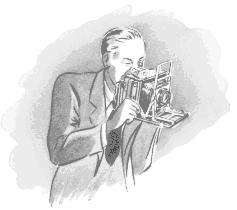| View previous topic :: View next topic |
| Author |
Message |
speedonut
Joined: 26 Jun 2005
Posts: 1
Location: Oklahoma
|
 Posted: Sat Jul 02, 2005 9:11 pm Post subject: Posted: Sat Jul 02, 2005 9:11 pm Post subject: |
 |
|
I need a new or used cord for my miniature 2x3 speed graphic. Any suggestions? I have not bought a flash attachment until I know I can get a cord. I do not have a synchronizable shutter.
Bob
|
|
| Back to top |
|
 |
bertsaunders
Joined: 20 May 2001
Posts: 577
Location: Bakersfield California
|
 Posted: Sat Jul 02, 2005 10:35 pm Post subject: Posted: Sat Jul 02, 2005 10:35 pm Post subject: |
 |
|
http://www.paramountcords.com
If you type this in on the search bar, there is usually a Graflex section posted, lots of good info there too!
Have a nice 4TH.........Bert |
|
| Back to top |
|
 |
Les
Joined: 09 May 2001
Posts: 2682
Location: Detroit, MI
|
 Posted: Sun Jul 03, 2005 12:24 am Post subject: Posted: Sun Jul 03, 2005 12:24 am Post subject: |
 |
|
The focal plane shutter won't give you the best results. There isn't a speed where the entire film is exposed at one time, so electronic flash is relagated to double tripping on the T (time) setting, which is usually too slow to work well anyway.
Now back in the heyday of flash bulbs, you could buy certain bulbs that would work with the flash at a couple of the top speeds, but the guide number was very low and now those bulbs are very expensive.
You will probably be better off hunting for a sync'd lens or at least one that has a solenoid attached to it.
Paramount is the best for custom cords and you'll know they work. Before Paramount came around the odds on favorite was to look for electric shaver cords. Several makes work, but never really went that route so I can't say exactly who.
Les
|
|
| Back to top |
|
 |
glennfromwy
Joined: 29 Nov 2001
Posts: 903
Location: S.W. Wyoming
|
 Posted: Mon Jul 04, 2005 12:29 am Post subject: Posted: Mon Jul 04, 2005 12:29 am Post subject: |
 |
|
To get focal plane sync using flash bulbs, you will need to find the following bulbs: #6 bayonet bulbs, no. 31 or no. 2A screw base bulbs.
_________________
Glenn
"Wyoming - Where everybody is somebody else's weirdo" |
|
| Back to top |
|
 |
phil-l
Joined: 05 May 2004
Posts: 2
Location: Mere Wiltshire England
|
 Posted: Mon Jul 04, 2005 3:23 pm Post subject: Posted: Mon Jul 04, 2005 3:23 pm Post subject: |
 |
|
Is there another supplier of flash cords than Paramount? My order was (auto) acknowleged, my money was taken, via PayPal: Which oganisation retrieved my money when no futher response (or flash cords) could be got from Paramount.
I'm in the UK, but P's site doesn't seem to be bothered by that? |
|
| Back to top |
|
 |
t.r.sanford
Joined: 10 Nov 2003
Posts: 812
Location: East Coast (Long Island)
|
 Posted: Wed Jul 06, 2005 4:58 am Post subject: Posted: Wed Jul 06, 2005 4:58 am Post subject: |
 |
|
I wouldn't give up on Paramount. It is a very old small company, run by a guy whose grandfather or somebody manufactured flashguns in the 1940s. I have had very good luck with Paramount over the years (and decades); they've gone out of their way to be helpful, and they sure know their cords and connectors!
If you've simply written them off, you probably will need to look for old ones often available from companies like Midwest Photo Exchange. These can be good or they can be dreadful -- it all depends on how they were used, and how they were stored. Right through the 1970s, flash cords tended to be insulated with what appears to be "live" rubber; it is susceptible to irremediable drying, cracking and flaking. (Paramount uses a plastic material, and offers a lifetime guarantee.) |
|
| Back to top |
|
 |
t.r.sanford
Joined: 10 Nov 2003
Posts: 812
Location: East Coast (Long Island)
|
 Posted: Thu Jul 07, 2005 1:01 am Post subject: Posted: Thu Jul 07, 2005 1:01 am Post subject: |
 |
|
...then again, one of the delights of the classic hand-and-stand camera and its large, low-voltage flashguns was that the cords were very simple and robust. Kalart cords looked as though they would work well if used to rewire a lamp.
With a few yards of zipcord, some U.S. household plugs and a decent junk box, you could make just about anything you'd need.
The only challenge is the round prongs used for the Graflex FP and all ASA bipost flash terminals. The tiny copper alligator clips sold by Radio Shack and others allow a good deal of tinkering and experimentation. When you have a circuit and a layout that pleases you, it ought to be feasible to secure some small copper tubing that will fit snugly over the pins, solder one to each of the two leads, put them in place, and surround the ensemble with an epoxy dough or other dielectric compound that will set hard.
The trick would be to keep the stuff from getting onto surfaces from which removing it would be inconvenient. |
|
| Back to top |
|
 |
|


